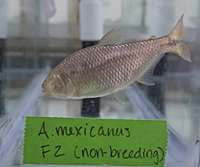Examination of a Cave-Dwelling Fish Finds a Possible Genetic Link to Human Disorders
Researchers have identified a genetic association with facial asymmetry in an ancient cavefish, a natural trait that may solve mysteries surrounding facial asymmetries in humans—conditions such as cleft palate or hemifacial microsomia. This discovery by Joshua Gross, a University of Cincinnati assistant professor for the Department of Biological Sciences; and doctoral students Amanda Krutzler and Brian Carlson, is published in the research journal, Genetics.
The researchers are studying the craniofacial features of the eyeless, cave-dwelling fish, Astyanax mexicanus, which has lived in the pitch-black caves of the Sierra de El Abra region of Mexico for millions of years. They’re comparing those features with closely related sighted surface-dwelling fish that are found in Mexico, Texas and New Mexico.
 These cavefish have no eyes, although they are acutely sensitive to sound and vibration. Despite being eyeless, they have several similar bony features in their eye regions compared to their sighted, surface- dwelling counterparts. These similarities allowed the researchers to directly compare traits in the surface-dwelling fish with the cavefish. The cavefish, however, appear drastically different since they are albino and nearly translucent, compared with the darker pigmented surface-dwelling fish.
These cavefish have no eyes, although they are acutely sensitive to sound and vibration. Despite being eyeless, they have several similar bony features in their eye regions compared to their sighted, surface- dwelling counterparts. These similarities allowed the researchers to directly compare traits in the surface-dwelling fish with the cavefish. The cavefish, however, appear drastically different since they are albino and nearly translucent, compared with the darker pigmented surface-dwelling fish.
The researchers are screening the genomes of every individual fish from a hybrid pedigree housed in their lab—looking for genes that may lead to variations in eye size or pigmentation. In the cavefish, they discovered genetic markers on two separate chromosomes that are associated with extensive bone fragmentation on the right side of the skull. Although bone fragmentation also occurs on the left side of the skull, no genetic associations were detected when scoring on the left side of the cranium. The sighted surface-dwelling fish never demonstrated any of these craniofacial abnormalities.
“By understanding how genes are behaving differently on the right versus the left sides, we hope to discover why many craniofacial alterations are more severe or present on only one side of the face in humans,” says Gross.
Researchers are now narrowing in on the precise genes associated with these cranial abnormalities, with indications that two genes previously shown to be associated with cleft palate in humans, bone morphogenetic protein number four (BMP4) and transforming growth factor beta family member 3 (TGFB3), may similarly be involved in natural forms of bone asymmetry.
Previous research discovered that the gene that causes red hair and pale skin in humans was the same gene that caused the albino-like cavefish to have less pigmentation than the surface-dwelling species.
Building a Family Pedigree
The researchers bred the cave fish with the surface-dwelling fish, and then intercrossed the hybrid offspring. Some members of this family pedigree resembled the albino qualities of the cave-dwelling fish but had a perfectly well-developed eye. Others demonstrated the dark pigmentation qualities of the surface-dwelling parent, but had a very small eye.
“We can make progress towards understanding the genetic origin of several analogous human disorders by expanding the repertoire of model systems represented by lab mice, zebrafish and so forth,” explains Gross. “Many techniques and technologies have been developed in these powerful model systems, however they’re extremely inbred. As a result, an inbred model system is not going to enable us to understand how and why craniofacial abnormalities evolve in nature. We can use the blind Pachón cave-dwelling fish to inform unresolved questions, such as how and why asymmetric craniofacial malformations occur in humans.”
“Additional research, utilizing an increasing number of emerging cave-dwelling models, offers the exciting prospect of clarifying longstanding problems in contemporary evolutionary and vertebrate biology,” says Gross.
The UC researchers are using cutting-edge technology as they build a high-resolution, three-dimensional reconstructions of hybrids of the surface-dwelling and cave-dwelling fish, Astyanax mexicanus. The researchers turned to the Imaging Resource Center at Cincinnati Children’s Hospital Medical Center to perform an imaging technique called micro-computed tomography, or micro-CT, on more than 200 related fish. The technology allowed the researchers to capture more than 1,000 X-ray images for each fish, which they combined and rendered into a high-resolution, 3-D skull, using the Amira software program.
Doctoral student and researcher Amanda Krutzler says the interactive program allows the researchers to rotate the fish skull in 3-D and take precise measurements for any traits of interest. In addition, micro-CT allows the researchers to visualize soft tissues, such as the brain or cardiovascular systems. “These scans will generate a massive amount of data for our lab, which will provide projects for undergraduate students and graduate students like me,” says Krutzler. The National Institute of Dental and Craniofacial Research grant provided the funding for the software.
In addition, doctoral student Brian Carlson used Circos software to visualize the connections between the cavefish genome and the zebrafish genome. “The more markers shared between a given cavefish linkage group and zebrafish chromosome, the thicker the ribbon that connects them. These representations are helpful in highlighting similarities between the cavefish and zebrafish genomes and may ultimately aid in identifying the genetic loci underlying the traits we examine by indicating which portions of the zebrafish genome may harbor genes that affect these traits,” says Carlson.
Source: University of Cincinnati




